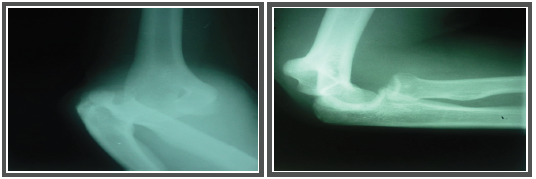- Submissions

Full Text
Orthopedic Research Online Journal
Anteromedial Dislocation of the Elbow: Case Report
Elghali H*, Elhaoury H, Chafik R, Madhar and Najeb Y
Orthopedic Surgery Departement, HUC Med VI Marrakesh, Morocco
*Corresponding author:Elghali H, Orthopedic Surgery Departement, HUC Med VI Marrakesh, Morocco
Submission: March 14, 2023;Published: April 12, 2023

ISSN: 2576-8875 Volume10 Issue3
Abstract
The Anteriomedial elbow dislocation in adult, without periarticular fracture (simple dislocation) is an extremely rare injury and is usually caused by distraction or torsional forces. In this article, we report our treatment experience with a case of Anteromedial dislocation of the elbow joint of a 19-‐ years-‐ old patient.
Keywords:Elbow injury; Dislocation; anterior
Introduction
The elbow dislocation is not an unusual injury. There is posterolateral displacement in most cases, only sporadic cases reports of anterior and medial dislocation of the elbow have appeared in the literature.
Case Report
A 19-year-old male, was admitted for closed trauma of upper right member. The cross examination adds a chute, elbow flexed and forearm pronated, during a game of handball. The patient had pain and functional impotence of upper right member. Clinically, the arm was deformed and swollen at the elbow, the olecranon fossa could be palpated to be empty.
The coronoid process was palpated in front of the elbow as expected. The radial pulse was palpable and normal. Movements of the joint were greatly restricted and painful. The function of the median and radial nerves was normal. Anteroposterior (AP) and lateral radiographs showed complete anterior and medial dislocation of the elbow (Figure 1 & 2). There was no fracture at the olecranon. Reduction was accomplished with the patient under general anaesthesia.
Figure 1&2:

The distal neurovascular examination was satisfactory, and radiographs confirmed a concentric reduction with no additional fractures (Figure 3 & 4). Removable posterior plaster splint was applied for 3 weeks with the elbow at about 90° of flexion. Ordinary physiotherapy followed after 3 weeks, and the elbow returned to normal within 4 months after injury, with complete elbow flexion, extension and rotation
Figure 3&4:

Discussion
The second most common joint dislocated in adults is the elbow, which accounts for 20% of all dislocations [1]. Posterior and posterolateral dislocations accounts for 80% to 90% of elbow dislocations [2]. Anterior elbow dislocation, however, has been described infrequently [3]. In our knowledge the association of antero-‐ medial dislocation of the elbow has never previously been described. Anterior dislocation of the elbow is a rare injury, occurring in between 0% and 2.6% of elbow dislocations [4]. Among 110 elbow dislocations reported by Linscheid and Wheeler, only 2 were anterior [5]. A fall on the back of the elbow with the joint in flexion is the most common mechanism of injury [6]. In most cases, ligamentous ruptures are combined with rupture or avulsion of the muscular origins at the epicondyls [7]. Reduction of an antero-‐ medial elbow dislocation can be achieved general anaesthesia or intravenous sedation most authors recommend 3 to 4 weeks of immobilization after reduction
Conclusion
A. Simple anterior and medial dislocation of elbow joint is
a rare injury and is usually caused by distraction or torsional
forces.
B. There is high incidence of associated musculoligamentous
injuries and should be looked for.
C. Reduction by closed method is possible. However, if
difficulty is encountered in achieving reduction by closed
technique it is wiser to do exploration and open reduction.
D. It is extremely important to check the stability of reduction
on table and when possible confirm with fluoroscopy. Definitive
treatment should not only be based on the severity of the
injury/instability, but also on the age, occupation, dominance
of the injured limb and associated injuries.
References
- Lansinger O, Karlsson J, Körner L, Måre K (1984) Dislocation of the elbow joint. Arch Orthop Trauma Surg 102(3): 183-186.
- Josefsson PO, Nilsson BE (1986) Incidence of elbow dislocation. Acta Orthop Scand 57: 538-539.
- Jackson AJ (1940) Single anterior dislocation of the elbow joint with rupture of the brachial artery. American Journal of Surgery 47(2): 479-486.
- Torchia ME, DiGiovine NM (1998) Anterior dislocation of the elbow in an arm wrestler. J Shoulder Elbow Surg 7(5): 539-541.
- Linscheid RL, Wheeler DK (1965) Elbow dislocations. J Bone Joint Surg Am 47: 1355-1364.
- Symeonides PP, Paschaloglou C, Stavrou Z, Pangalides T (1975) Recurrent dislocation of the elbow. J Bone Joint Surg Am 57(8): 1084-1086.
- Lui D, Boran S, Lenehan B, Jones D, Fogarty E (2007) Open postéro-medial dislocation of the elbow in a 11-year old. Injury Extra 38(10): 365-368.
© 2023 Elghali H. This is an open access article distributed under the terms of the Creative Commons Attribution License , which permits unrestricted use, distribution, and build upon your work non-commercially.
 a Creative Commons Attribution 4.0 International License. Based on a work at www.crimsonpublishers.com.
Best viewed in
a Creative Commons Attribution 4.0 International License. Based on a work at www.crimsonpublishers.com.
Best viewed in 







.jpg)






























 Editorial Board Registrations
Editorial Board Registrations Submit your Article
Submit your Article Refer a Friend
Refer a Friend Advertise With Us
Advertise With Us
.jpg)






.jpg)














.bmp)
.jpg)
.png)
.jpg)










.jpg)






.png)

.png)



.png)






